Tag: politics
Utopia or dystopia?
15 October 2013 | This 'n' that
 ‘The fate of our societies lies in equity’, claims Martti Ahtisaari – winner of the Nobel Peace Prize in 2008 – in his foreword to a study entitled A recipe for a better life: Experiences from the Nordic countries (2013).
‘The fate of our societies lies in equity’, claims Martti Ahtisaari – winner of the Nobel Peace Prize in 2008 – in his foreword to a study entitled A recipe for a better life: Experiences from the Nordic countries (2013).
The study was compiled and written by Heikki Hiilamo and Olli Kangas with Johan Fritzell, Jon Kvist and Joakim Palme and published by Crisis Management Initiative (a Finnish, independent, non-profit organisation founded in 2000 by Ahtisaari, President of Finland from 1994 to 2000). It is available here.
‘The Nordic experience’ is presented in chapters dealing with the trustworthiness of the society, the role of the state, the amount of efficiency and inefficiency as well as the homogeneity of the Nordic societies and the social investments of these societies in their citizens.
(The Nordic countries consist of Denmark, Finland, Iceland, Norway and Sweden as well as their associated territories – with different levels of autonomy – the Faroe Islands and Greenland [Denmark] and Åland [Finland].)
‘"The Nordic enigma" is a successful marriage between hard-core competitive capitalism
and the pursuit of egalitarian policies’.
The study provides a concise summary of how these societies function with additional comments on the socio-historical development of independent Finland. It presents the reader with pros and cons, arguments and facts.
‘For some analysts the Nordic welfare state is a dystopia to be avoided at all costs....
It is simply argued that that the welfare state destroys the incentives to work.’
‘Despite their strong welfare states and heavy tax burdens – often said to be poison
to competitiveness – the Nordic countries are doing well in economic terms.’
The reader is indeed challenged to ponder the best recipes for a better life. Last but not least: how will the ‘recipes’ need to be adapted in the future?
Johanna Korhonen: Kymmenen polkua populismiin [Ten paths to populism]
3 October 2013 | Mini reviews, Reviews
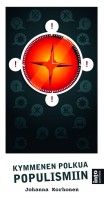 Kymmenen polkua populismiin. Kuinka vaikenevasta Suomesta tuli äänekkään populismin pelikenttä
Kymmenen polkua populismiin. Kuinka vaikenevasta Suomesta tuli äänekkään populismin pelikenttä
[Ten paths to populism. How silent Finland became a playing field for loud populism]
Helsinki: Into Kustannus Oy, 2013. 81p.
ISBN 951-952-264-257-8
€15, paperback
This pamphlet on the populist True Finns party was commissioned by the British think tank Counterpoint (PDF available in Finnish). In 2011, under the leadership of the rhetorically gifted Timo Soini, the True Finns became the largest opposition party in the Finnish parliament. In the background of this phenomenon the journalist Johanna Korhonen sees, among other things, the recession of the 1990s, the fear of economic insecurity, and the paucity of alternatives and debate that characterise politics in Finland. The left-leaning party favours simplifications and longs for national unity and security. It nevertheless includes an extremist nationalist minority whose agenda includes resistance to the European Union, cultural diversity, minority rights and foreign influences, and can even be racist. Korhonen focuses and simplifies in pamphleteering fashion, but argues patiently, basing her views on facts, and considers the beneficial effects the populist party has had on the national debate, offering her suggestions for a more humane politics.
Translated by Hildi Hawkins
Elitist versus pop?
8 August 2013 | Letter from the Editors

An elitist of his time? A caricature of Richard Wagner by Leslie Ward, published in Vanity Fair in 1877 (caption read ‘The Music of the Future’). Picture: Wikimedia
The old phrase ‘art for art’s sake’ has begun to sound like an appeal instead of an bohemian creed, without any negative ambiguity. Please let art be created for art’s sake!
In our times of neo-liberal ideologies, the criteria for assessing art include its capacity to generate profits to creative industries, to have export value, to be of assistance to business in general. But art, in essence, serves no ideology.
Technology now allows us to be more entertained than ever before, if we so choose. Art and entertainment alike come to us by the use of various devices. What has often been called ‘elitist’ art – opera, modern music, ballet – can be enjoyed lying on the sofa in the home. Money is not an obstacle.
Art, too needs money, of course: orchestras, theatres, training of artists and artists themselves need subsidies from society. Entertainment is by nature profitable business, as it attracts and involves large paying audiences. Smaller audiences want to listen to classical music, read books and see films that are not made solely in order to bring in as much money as possible. But why should these forms of art be called ‘elitist’? More…
Reindeer yoga?
15 July 2013 | This 'n' that

Human yoga wheel. Photo: Wikimedia
While Finnish politicians, just back at Parliament after their summer break, twiddle their thumbs in frustration as the nation faces darkening prospects for economic growth, Finland is being admired across the pond.
The Atlantic magazine took a long look at ‘the secrets of Finland’s success with schools, moms, kids – and everything’ (July 2013).
Olga Khazan reports: Finns enjoy long vacations, better school scores, unemployment insurance, paid parental leaves, cheap child care, education and medical services, and low infant mortality rates.
‘All of this adds up to the stress equivalent of living in what is essentially a vast, reindeer-fur-lined yoga studio.’
Whoa! Are we that happy in Finland? More…
Eveliina Talvitie: Keitäs tyttö kahvia. Naisia politiikan portailla [Put the kettle on, girl. Women on the ladder of politics]
23 May 2013 | Mini reviews, Reviews
 Keitäs tyttö kahvia. Naisia politiikan portailla
Keitäs tyttö kahvia. Naisia politiikan portailla
[Put the kettle on, girl. Women on the ladder of politics]
Helsinki: WSOY, 2013. 332 p., ill.
ISBN 978-951-0-39485-4
€29, hardback
In 1906 Finnish women were the first in Europe to obtain the right to vote, and Finland, like the other Nordic countries, is viewed as a model of equality. Journalist and author Eveliina Talvitie examines the role of women in politics. She has interviewed seventeen Finnish female politicians, more than half of whom have served as cabinet ministers. Among them are former President Tarja Halonen and Elisabeth Rehn, who has long worked on international assignments – between her and the youngest politician in the book there is a 52-year age gap. The interviewees describe the different aspects of the progress of their careers, their successes and setbacks. At the end of each chapter the author considers the challenges faced by female politicians from a particular point of view, backing up her conclusions with supplementary interviews. Not all of the politicians in the book have been handicapped because of their gender, but the work clearly demonstrates that, even in a relatively egalitarian country, female politicians are still treated differently from men, and their career paths can often be more difficult than those of their male colleagues.
Translated by David McDuff
What does the neighbour think?
26 April 2013 | Essays, Non-fiction
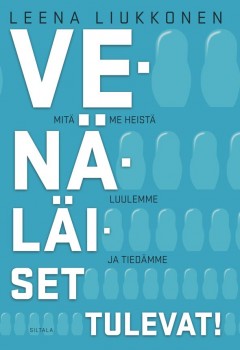 For more than 20 years journalist Leena Liukkonen has been thoroughly involved with Russian culture, commerce, language and psyche. The subtitle of her new book of essays Venäläiset tulevat! (‘The Russians are coming!’) is ‘What we think and know about them’, and refers to the fact that the Finns do not really know their eastern neighbours very well. Liukkonen writes with insight about the differences in history, mentality and world view
For more than 20 years journalist Leena Liukkonen has been thoroughly involved with Russian culture, commerce, language and psyche. The subtitle of her new book of essays Venäläiset tulevat! (‘The Russians are coming!’) is ‘What we think and know about them’, and refers to the fact that the Finns do not really know their eastern neighbours very well. Liukkonen writes with insight about the differences in history, mentality and world view
Extracts (under original subtitles) from Venäläiset tulevat! Mitä me heistä luulemme ja tiedämme (Siltala, 2013)
WAR, REMEMBERING AND FORGETTING
In café conversations with other visitors to Russia, we often react with exasperation to the fact that discussions in Finland only ever start with the Winter War. Sometimes we wonder why the threshold between us and our neighbour to the east is still so high. My own living contact with the past, however, makes it clear to me that everything the elderly carry round with them could not have been simply shaken off with the passage of time. Nor can the next generation just break away from it. My own experience also reminds me how distant our eastern neighbour was during peacetime. After all, a very few have made the long journey to the country next door. To many people, the old story was the only story there was about Russia. More…
Maailman paras maa [The best country in the world]
14 March 2013 | Mini reviews, Reviews
 Maailman paras maa
Maailman paras maa
[The best country in the world]
Toim. [Ed. by] Anu Koivunen
Helsinki: Suomalaisen Kirjallisuuden Seura, 2012. 255 p., ill.
ISBN 978-952-222-347-0
€ 37, paperback
In this book twelve writers, representing various fields of research, ponder Finland and Finnishness from the viewpoint of history, ethnology, society, culture and economics. Finland-Swedishness and the relationship between Finns and Russians, the need of Finns to defend their participation in the Second World War in alliance with Germany as a ‘separate war’, and the nostalgia related to lost Karelia. The articles deal with Finland facing economic challenges, attitudes towards foreign beggars and self-critical Finnish opinion pieces. They also take a look at Finnish man as portrayed in the classic novel Seitsemän veljestä (‘The seven brothers’, 1870, by Aleksis Kivi) and in a recent prize-winning film about men talking in the sauna about their feelings, and discuss the relationship of the two national languages, Finnish and Swedish. Well-written and original articles question truisms and challenge the reader contemplate his or her own relationship with Finnishness.
Osmo Jussila: Neuvostoliiton tragedia. Utopiasta vankileirien saaristoksi [The tragedy of the Soviet Union. From utopia to Gulag Archipelago]
31 January 2013 | Mini reviews, Reviews
 Neuvostoliiton tragedia. Utopiasta vankileirien saaristoksi
Neuvostoliiton tragedia. Utopiasta vankileirien saaristoksi
[The tragedy of the Soviet Union. From utopia to Gulag Archipelago]
Helsinki: Otava, 2012. 448 p., ill.
ISBN 978-951-1-26521-4
€32.80, hardback
The acclaimed Russian and Soviet history scholar Osmo Jussila examines the early history of the Soviet Union from a fresh perspective. He shows how, in the years following the 1917 Revolution, an originally positive idea for a better society turned into a bureaucratic tyranny. The Soviet Union’s strong man V.I. Lenin created the Bolshevist Party as a paramilitary organisation which managed to seize power in October 1917. Even in the early years of Soviet power the ‘Red Terror’ crushed its opponents with executions and the establishment of prison camps. Although Lenin was a good professional revolutionary, he was almost incapable of building a new society: his solutions were often cruel, arbitrary and hasty. Jussila’s general view of Lenin is in line with the ideas that are familiar from more recent historical research, but the author also focuses and deepens his analysis to provide an essentially complete picture of Soviet Russia’s chaotic development and of Lenin’s role in the formation of the oppressive Soviet state.
Translated by David McDuff
Jukka Tarkka: Karhun kainalossa. Suomen kylmä sota 1947–1990 [Under the arm of the Bear. Finland’s Cold War 1947–1990]
18 October 2012 | Mini reviews, Reviews
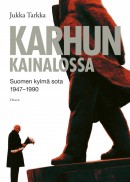 Karhun kainalossa. Suomen kylmä sota 1947–1990
Karhun kainalossa. Suomen kylmä sota 1947–1990
[Under the arm of the Bear. Finland’s Cold War 1947-1990]
Helsinki: Otava, 2012. 495 p, ill.
ISBN 978-951-1-25796-7
€ 36.70, hardback
Historian and author Jukka Tarkka’s book describes relations between Finland and the ‘Bear’ (i.e. the Soviet Union) during the Cold War, from the Paris Peace Treaty which ended Finland’s part in the Second World War to the new interpretation of some of the Treaty’s key points in 1990. Many people consider that Finland fell too much under the Soviet Union’s influence and became ‘Finlandised’. Tarkka shows that although in some cases Finland did give in, it also resisted Soviet pressure, built cultural and economic relations with the Western democracies and established an independent defence. In the light of its declared neutrality during the Cold War, Finland’s rapid integration into the EU is not at all surprising. The central figure in the thematically structured book is Urho Kekkonen, the country’s president for a quarter of a century. Kekkonen led the political struggle, but at the same time used the threat of the eastern neighbour as a weapon of domestic policy, as did many less influential figures in his shadow. Without sacrificing scholarly rigour Tarkka has written a popularly accessible outline of an important subject, relying on sources and references.
Translated by David McDuff
Jussi Pekkarinen: Maailmanluokan tarkkailupaikka. Suomen Lontoon suurlähetystön historia [A world-class observation post. The history of Finland’s London embassy]
28 September 2012 | Mini reviews, Reviews
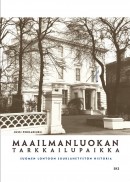 Maailmanluokan tarkkailupaikka. Suomen Lontoon suurlähetystön historia
Maailmanluokan tarkkailupaikka. Suomen Lontoon suurlähetystön historia
[A world-class observation post. The history of Finland’s London embassy]
Helsinki: Finnish Literature Society, 2012. 380 p., ill.
ISBN 978-952-222-365-4
€ 38, hardback
Finland’s diplomatic mission in London began its formation after the country gained its independence in 1918 and was officially recognised by Britain in 1919. The Embassy has always been important to Finland because of Britain’s leading significance for Finland and because Britain has been one of Finland’s most prominent trading partners. This interestingly written history, based on Finnish and British sources, also portrays the development of relations between the two countries. The ambassadors have been colourful and quick-tongued personalities; Pekkarinen describes some of the blunders caused by staff conflicts and cultural differences. As diplomacy is not merely representation – which in itself is a full-time job – it requires a mastery of issues relating to trade and politics. In addition to its depiction of the day-to-day work of the embassy staff, the book provides more general information about the diplomatic mission. Pekkarinen – a researcher in the Foreign Ministry – covers the period up to the early 1990s, but the concluding part of the book is a review of the embassy’s situation today by the current ambassador.
Translated by David McDuff
Do you speak my language?
23 August 2012 | Articles, Non-fiction
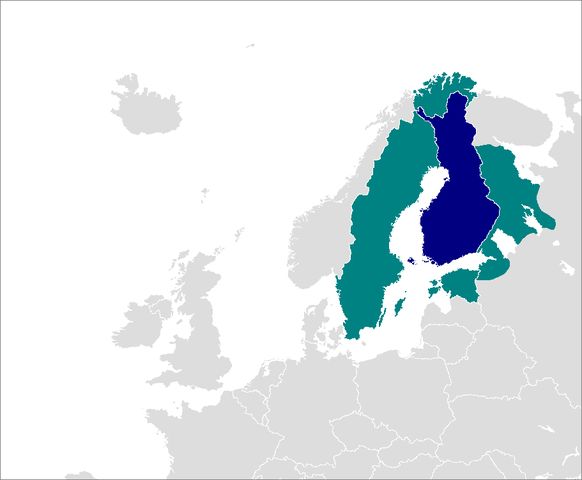
Finnish spoken outside Finland: Sweden (west), Estonia (south), Karelia/Russia (east), Norway (north). Illustration: Zakuragi/Wikipedia
Finland has two official languages, Finnish and Swedish. Approximately five per cent of the population (290,000 Finns) speak Swedish as their native language. All Finns learn both languages at school, and students in higher education must prove they have an adequate knowledge of the other mother tongue. But how do native speakers of Finnish cope with what is, for many of them, a minority language that they will never need or even wish to use? We take a look at bilingual issues – and a new book devoted to them
‘In many parts of the world, language can be a fiery and divisive issue, one that pits the powerless against the powerful, the small against the big. The Basques battle the Spanish. The Flemish tussle with the Walloons. The Québécois scuffle with the rest of Canada.’
That is how Lizette Alvarez illustrated her theme in her article ‘Finland Makes Its Swedes Feel at Home’, published in the New York Times in 2005.
In Finland, language has been a fiery issue at times, though things have cooled down a bit since the early 20th century. The use of Finnish as a written language dates back to the 16th century, but the territory of Finland was part of the Swedish Empire until 1809. Swedish was spoken by the nobility as well as most of the peasant class – the mechanism of the state did not serve Finnish-speaking peasants or other segments of the population in Finnish. More…
Joni Krekola: Maailma kylässä 1962. Helsingin nuorisofestivaali [The world comes to visit in 1962. Helsinki’s youth festival]
3 August 2012 | Mini reviews, Reviews
 Maailma kylässä 1962. Helsingin nuorisofestivaali
Maailma kylässä 1962. Helsingin nuorisofestivaali
[The world comes to visit in 1962. Helsinki’s youth festival]
Helsinki: Like, 2012. 310 p., ill.
ISBN 978-952-01-0757-4
€ 27.10, paperback
In the summer of 1962, in the middle of the Cold War, a week-long youth festival was held in Helsinki. Behind the scenes of the event a propaganda war between East and West was being waged, something not uncommon at such festivals, which were the venue for meetings of the International Union of Socialist Youth (IUSY, founded 1907). The main organisers were the World Federation of Democratic Youth (WFDY, 1945), generally regarded as a Soviet propaganda agency, and the International Union of Students (IUS, 1946). The Finnish government’s initially lukewarm attitude to the event turned more positive as a result of the influence of the the Soviet Union. Helsinki hosted some 12,000 guests from all over the world at the ‘Peace and Friendship’ festival, with a couple of thousand Finns taking part. To Finns, the festival introduced colourful and exotic foreign life, a novelty in the country at the time. Resistance to the festival sparked youth riots which were suppressed by the police, and a smaller shadow event was organised mainly with CIA funding. Although the press condemned the unrest, it kept fairly silent about the festival itself. According to Joni Krekola, however, it was a success; in his interesting book he studies a major event that historians have overlooked, its diverse programme, its side- and after-effects, and its wider impact on society.
Translated by David McDuff
Panem et circenses, Part II
10 May 2012 | This 'n' that

The Guggenheim Foundation's global network of museums
Helsinki has said no thanks to a new Guggenheim art museum in the city – for the time being, at least.
On 2 May the City Council voted 8-7 against the mayor’s motion to build such a gallery in Helsinki. Politically, the move was supported by the National Coalition Party and the Swedish People’s Party, while the Greens and the left-wing parties opposed it.
What happens after the upcoming national elections – in autumn this year – is another matter. The director of the Guggenheim Foundation, Richard Armstrong, is persistent: he says he wants Helsinki. Well, if the Foundation offers a better deal in the future, the proposal may be considered again.
Three months ago we wondered – see Panem et circenses – whether ‘the people of Helsinki wish to begin to pay additional taxes for the revival, yet again, of the age-old dream of guaranteeing Finland “a place on the world map”, in a situation where economic difficulties are a matter of everyday life for increasing numbers of them? (We believe, incidentally, that Finland already has an appropriate place on the world map.) Will their opinion be asked, or heard?’ More…
Nationalism in war and peace
3 May 2012 | Reviews
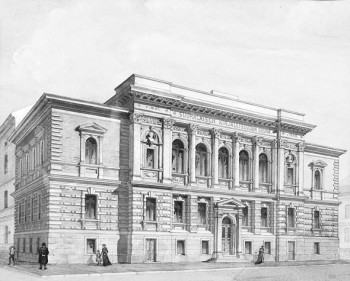
House of words: the Finnish Literature Society building in Helsinki. Architect Sebastian Gripenberg, 1890. Watercolour by an unknown Russian artist, 1890s
Kai Häggman
Sanojen talossa. Suomalaisen Kirjallisuuden Seura 1890-luvulta talvisotaan
[In the house of words. The Finnish Literature Society from the 1890s to the Winter War]
Helsinki: Suomalaisen Kirjallisuuden Seura, 2012. 582 p., ill.
ISBN 978-952-222-328-9
€54, hardback
The Finnish Literature Society has, throughout its history, played a multiplicity of roles: fiction publisher, research institute specialising in folklore studies, organiser of mass campaigns in support of national projects, literary gatekeeper, learned society, controller of language development.
The priorities of these areas of interest have changed from decade to decade, so Kai Häggman has taken on an exceptionally difficult subject to describe. He has, however, succeeded brilliantly in gathering the different threads together, using as as lowest common denominator the ideas of nationalism and nation whose role in global modernisation and European history have been studied, among others, by the British historians Ernest Gellner and Eric Hobsbawm. More…

